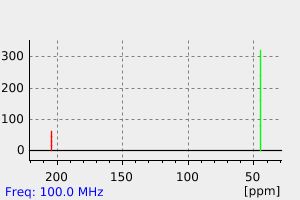cyclic succinic selenoanhydride | 26562-21-0
中文名称
——
中文别名
——
英文名称
cyclic succinic selenoanhydride
英文别名
succinic selenoanhydride;dihydro-selenophene-2,5-dione;Duvwuhnqidothx-uhfffaoysa-;selenolane-2,5-dione
CAS
26562-21-0
化学式
C4H4O2Se
mdl
——
分子量
163.035
InChiKey
DUVWUHNQIDOTHX-UHFFFAOYSA-N
BEILSTEIN
——
EINECS
——
-
物化性质
-
计算性质
-
ADMET
-
安全信息
-
SDS
-
制备方法与用途
-
上下游信息
-
文献信息
-
表征谱图
-
同类化合物
-
相关功能分类
-
相关结构分类
物化性质
-
沸点:244.4±23.0 °C(Predicted)
计算性质
-
辛醇/水分配系数(LogP):-0.46
-
重原子数:7
-
可旋转键数:0
-
环数:1.0
-
sp3杂化的碳原子比例:0.5
-
拓扑面积:34.1
-
氢给体数:0
-
氢受体数:2
反应信息
-
作为反应物:描述:参考文献:名称:Selenienoquinonoid-Extended Analogues of TTF, EDT-TTF, and BEDT-TTF. New Donors and Their Conductive Complexes摘要:我们采用简便的方法合成了 2,5-双(1,3-二硫醇-2-亚基)-2,5-二氢硒吩(BDTS)及其二硫代乙烷(EDT-BDTS)和二(二硫代乙烷)(BEDT-BDTS)衍生物,它们是具有一个中心硒原子的新型扩展供体。其中,EDT-BDTS 和 BEDT-BDTS 具有外层的查尔根原子,能与 TCNQ 形成高导电性的分子络合物(压缩颗粒上的σ = 13 Scm-1)。DOI:10.1246/cl.1995.619
-
作为产物:参考文献:名称:Reactions of acyl chlorides with LiAlHSeH. Preparation of diacyl selenides, diacyl diselenides, selenocarboxylates and cyclic selenoanhydrides摘要:几种酰基氯与 LiAlHSeH 反应合成了各种二酰基硒化物、二酰基二硒化物和硒羧酸盐。二酰氯与 LiAlHSeH 反应生成了环硒酸酐。在 77Se NMR 光谱中,我们发现二酰基硒化物和二酰基二硒化物的化学位移有助于区分它们。DOI:10.1039/b200147k
文献信息
-
Reaction of Primary Selenoamides with Bisacyl Chlorides: Syntheses of 6-Hydroxy-1,3-selenazin-4-ones and Selenoanhydrides作者:Mamoru Koketsu、Sohma Hiramatsu、Hideharu IshiharaDOI:10.1246/cl.1999.485日期:1999.6The reaction of primary selenoamides with bisacyl chlorides in the presence of Et3N was investigated. By the reaction with malonyl chloride, 6-hydroxy-1,3-selenazin-4-ones were provided in high yield. By the reactions with succinyl chloride, glutaryl chloride, and phthaloyl chloride, the corresponding selenoanhydrides were obtained in moderate yields, respectively.
-
Synthesis and X-ray crystal structure of a selenophenoquinonoid-extended donor, BEDT–BDTS, affording highly conducting tetracyanoquinodimethaneand I3 complexes作者:Kazuko Takahashi、Takashi Shirahata、Kensuke TomitaniDOI:10.1039/a703428h日期:——2,5-Bis(4,5-ethylenedithio-1,3-dithiol-2-ylidene)-2,5-dihydroselenophe++ne (BEDTâBDTS), a selenophenoquinonoid-extended analogue of bis(ethylenedithio)tetrathiafulvalenes (BEDTâTTF), has been synthesized as a promising candidate for an electron-donating component of highTc organic superconductors. BEDTâBDTS is air-stable and has a significantly enhanced electron-donating ability compared with that of BEDTâTTF. The molecular and crystal structures of BEDTâBDTS have been determined by single crystal X-ray analysis in which short intermolecular SS contacts have been found in the side-by-side directions of the donor arrangements. A 1:1 TCNQ complex and a 3:1 I3â radical cation salt of BEDTâBDTS have been obtained and proved to exhibit fairly high room temperature conductivities.
表征谱图
-
氢谱1HNMR
-
质谱MS
-
碳谱13CNMR
-
红外IR
-
拉曼Raman
-
峰位数据
-
峰位匹配
-
表征信息
同类化合物
()-2-(5-甲基-2-氧代苯并呋喃-3(2)-亚乙基)乙酸乙酯
(双(2,2,2-三氯乙基))
(乙基N-(1H-吲唑-3-基羰基)ethanehydrazonoate)
(Z)-3-[[[2,4-二甲基-3-(乙氧羰基)吡咯-5-基]亚甲基]吲哚-2--2-
(S)-(-)-5'-苄氧基苯基卡维地洛
(S)-(-)-2-(α-(叔丁基)甲胺)-1H-苯并咪唑
(S)-(-)-2-(α-甲基甲胺)-1H-苯并咪唑
(S)-氨氯地平-d4
(S)-8-氟苯并二氢吡喃-4-胺
(S)-4-(叔丁基)-2-(喹啉-2-基)-4,5-二氢噁唑
(S)-4-氯-1,2-环氧丁烷
(S)-3-(2-(二氟甲基)吡啶-4-基)-7-氟-3-(3-(嘧啶-5-基)苯基)-3H-异吲哚-1-胺
(S)-2-(环丁基氨基)-N-(3-(3,4-二氢异喹啉-2(1H)-基)-2-羟丙基)异烟酰胺
(SP-4-1)-二氯双(喹啉)-钯
(SP-4-1)-二氯双(1-苯基-1H-咪唑-κN3)-钯
(R,S)-可替宁N-氧化物-甲基-d3
(R,S)-六氢-3H-1,2,3-苯并噻唑-2,2-二氧化物-3-羧酸叔丁酯
(R)-(+)-5'-苄氧基卡维地洛
(R)-(+)-2,2'',6,6''-四甲氧基-4,4''-双(二苯基膦基)-3,3''-联吡啶(1,5-环辛二烯)铑(I)四氟硼酸盐
(R)-卡洛芬
(R)-N'-亚硝基尼古丁
(R)-DRF053二盐酸盐
(R)-4-异丙基-2-恶唑烷硫酮
(R)-3-甲基哌啶盐酸盐;
(R)-2-苄基哌啶-1-羧酸叔丁酯
(N-(Boc)-2-吲哚基)二甲基硅烷醇钠
(N-{4-[(6-溴-2-氧代-1,3-苯并恶唑-3(2H)-基)磺酰基]苯基}乙酰胺)
(E)-2-氰基-3-(5-(2-辛基-7-(4-(对甲苯基)-1,2,3,3a,4,8b-六氢环戊[b]吲哚-7-基)-2H-苯并[d][1,2,3]三唑-4-基)噻吩-2-基)丙烯酸
(E)-2-氰基-3-[5-(2,5-二氯苯基)呋喃-2-基]-N-喹啉-8-基丙-2-烯酰胺
(8α,9S)-(+)-9-氨基-七氢呋喃-6''-醇,值90%
(6R,7R)-7-苯基乙酰胺基-3-[(Z)-2-(4-甲基噻唑-5-基)乙烯基]-3-头孢唑啉-4-羧酸二苯甲基酯
(6-羟基嘧啶-4-基)乙酸
(6,7-二甲氧基-4-(3,4,5-三甲氧基苯基)喹啉)
(6,6-二甲基-3-(甲硫基)-1,6-二氢-1,2,4-三嗪-5(2H)-硫酮)
(5aS,6R,9S,9aR)-5a,6,7,8,9,9a-六氢-6,11,11-三甲基-2-(2,3,4,5,6-五氟苯基)-6,9-甲基-4H-[1,2,4]三唑[3,4-c][1,4]苯并恶嗪四氟硼酸酯
(5R,Z)-3-(羟基((1R,2S,6S,8aS)-1,3,6-三甲基-2-((E)-prop-1-en-1-yl)-1,2,4a,5,6,7,8,8a-八氢萘-1-基)亚甲基)-5-(羟甲基)-1-甲基吡咯烷-2,4-二酮
(5E)-5-[(2,5-二甲基-1-吡啶-3-基-吡咯-3-基)亚甲基]-2-亚磺酰基-1,3-噻唑烷-4-酮
(5-(4-乙氧基-3-甲基苄基)-1,3-苯并二恶茂)
(5-溴-3-吡啶基)[4-(1-吡咯烷基)-1-哌啶基]甲酮
(5-氯-2,1,3-苯并噻二唑-4-基)-氨基甲氨基硫代甲酸甲酯一氢碘
(5-氨基-6-氰基-7-甲基[1,2]噻唑并[4,5-b]吡啶-3-甲酰胺)
(5-氨基-1,3,4-噻二唑-2-基)甲醇
(4aS-反式)-八氢-1H-吡咯并[3,4-b]吡啶
(4aS,9bR)-6-溴-2,3,4,4a,5,9b-六氢-1H-吡啶并[4,3-B]吲哚
(4S,4''S)-2,2''-环亚丙基双[4-叔丁基-4,5-二氢恶唑]
(4-(4-氯苯基)硫代)-10-甲基-7H-benzimidazo(2,1-A)奔驰(德)isoquinolin-7一
(4-苄基-2-甲基-4-nitrodecahydropyrido〔1,2-a][1,4]二氮杂)
(4-甲基环戊-1-烯-1-基)(吗啉-4-基)甲酮
(4-己基-2-甲基-4-nitrodecahydropyrido〔1,2-a][1,4]二氮杂)
(4,5-二甲氧基-1,2,3,6-四氢哒嗪)







